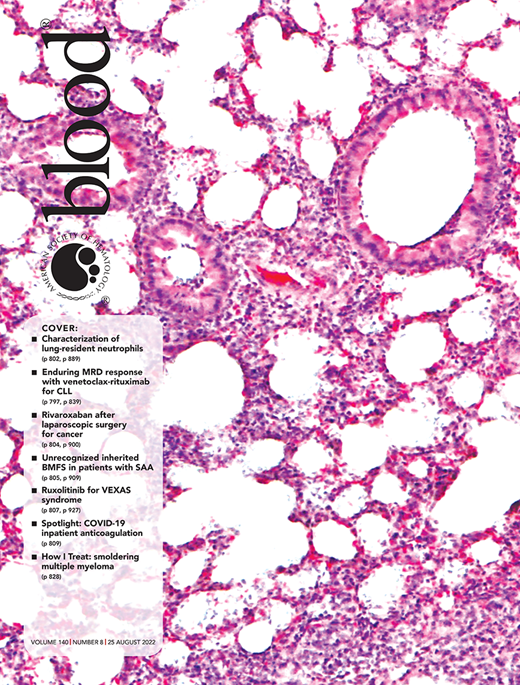In this issue of Blood, Heiblig et al1 report on the efficacy of Janus kinase (JAK) inhibition in treating patients who have VEXAS (vacuoles in myeloid progenitors, E1 ubiquitin–activating enzyme, X-linked, autoinflammatory manifestations, somatic) syndrome. VEXAS syndrome is a recently described disorder consequent to somatic mutation in the UBA1 gene.2
Patients with VEXAS syndrome present with various combinations of inflammatory symptoms that mimic different rheumatic diseases and hematologic conditions (myelodysplastic syndrome or monoclonal gammopathy). Resistance to treatment is one of the characteristics that a patient who is initially suspected of having a rheumatic disease may have VEXAS syndrome instead. Although sporadic cases are identified among this population of patients with treatment-resistant rheumatic disease, screening studies have demonstrated a high diagnostic yield in undiagnosed cytopenic males, with VEXAS syndrome identified in 1% of such cases.3 To date, only high-dose glucocorticoids have demonstrated significant efficacy in treating VEXAS syndrome, but symptoms frequently relapse when any dose reduction is attempted, and sustained high-dose glucocorticoids have an unacceptable safety profile.2
It is noteworthy that in the study by Heiblig et al, the authors describe evidence of significant treatment efficacy with the preferential JAK1/2 inhibitor ruxolitinib. Other JAK inhibitors also seem to have some, albeit lesser, efficacy in treating VEXAS syndrome. The authors describe 30 patients treated with JAK inhibitors. At months 1, 3, and 6 after beginning treatment with a JAK inhibitor, a clinical response was seen in 50%, 57%, and 82%, respectively, of those remaining on treatment. These overall results masked the marked discrepancies between individual JAK inhibitors; rates of clinical remission favored ruxolitinib over other JAK inhibitors at 67% vs 38% at month 1, 83% vs 18% at month 3, and 87% vs 11% at month 6. There was also a marked steroid dose reduction of 83.6% with ruxolitinib and 75% with other JAK inhibitors; 3 patients stopped glucocorticoid treatment entirely. The significant reductions in glucocorticoid dose suggests that the benefit of JAK inhibitors other than ruxolitinib is possibly greater than would be suggested by the headline numbers, because patients with VEXAS syndrome tend to be extremely resistant to glucocorticoid reduction. The majority of patients who stopped JAK inhibitors did so because of lack of efficacy, and the majority of those were receiving drugs other than ruxolitinib. Infections and thromboembolic disease were common, but these are already common complications of VEXAS syndrome, so the result are difficult to interpret.
The study by Heiblig et al has some important limitations that should be considered. The study was essentially a retrospective case series, although it was an international multicenter study that had a relatively large number of patients with this rarely diagnosed disease. The open-label nature of this study, retrospective data collection, and lack of a comparator group have the potential to introduce bias. More data are needed before we can have confidence in these provisional findings. Traditionally, these problems would be addressed in a randomized controlled trial, but conducting such trials is challenging with a rare condition such as VEXAS syndrome. The use of a large-scale network pragmatic clinical trial design may provide an ideal setting for solving such a problem. It was reassuring to see that multiple centers contributed to the Heiblig et al study, and hopefully this collaboration can be leveraged to support future efforts.
It is encouraging to know that we now have supportive evidence of efficacy for an extant treatment in VEXAS syndrome. Further clinical trials are needed in this area, but they will be challenging and will benefit from innovative approaches. In the interim, these new data support the use of ruxolitinib in treating VEXAS syndrome.
Conflict-of-interest disclosure: R.C. was a member of the speakers bureau for Janssen, Roche, Sanofi, and AbbVie and received research funding related to AbbVie clinical trials (CONTExT-RA, UPHOLD, SENSE). Research funding from Janssen was an unrestricted education grant.

